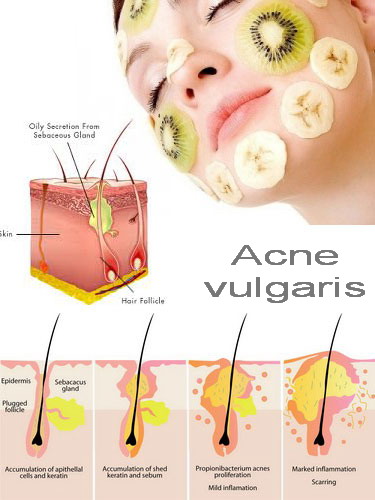Title : Acne Vulgaris
link : Acne Vulgaris
Acne Vulgaris
Acne vulgaris, also known as common acne, is an inflammatory condition of the sebaceous glands of the skin. It consists of red, elevated areas on the skin that may develop into pustules and even further into cysts that can cause scarring.
Acne vulgaris occurs mostly on the face, neck, and back of most commonly teenagers and to a lesser extent of young adults. The condition results in part from excessive stimulation of the skin by androgens (male hormones). Bacterial infection of the skin also appears to play a role.
What are the symptoms of acne?
Acne is a skin condition characterized by pimples, which may be closed (sometimes called pustules or “white heads”) or open (blackheads), on the face, neck, chest, back, and shoulders. Most acne is mild, although some people experience inflammation with larger cysts, which may result in scarring.
Dietary changes that may be helpful
Many people assume certain aspects of diet are linked to acne, but there is not much evidence to support this idea. Preliminary research found, for example, that chocolate was not implicated. Similarly, though a diet high in iodine can create an acne-like rash in a few people; this is rarely the cause of acne. In a preliminary study, foods that patients believed triggered their acne failed to cause problems when tested in a clinical setting. Some doctors of natural medicine have observed that food allergy plays a role in some cases of acne, particularly adult acne. However, that observation has not been supported by scientific studies.
Nutritional supplements that may be helpful
In a double-blind trial, topical application of a 4% Niacinamide gel twice daily for two months resulted in significant in improvement in people with acne. However, there is little reason to believe this vitamin would have similar actions if taken orally.
Several double-blind trials indicate that zinc supplements reduce the severity of acne. In one double-blind trial, though not in another, zinc was found to be as effective as oral antibiotic therapy. Doctors sometimes suggest that people with acne take 30 mg of zinc two or three times per day for a few months, then 30 mg per day thereafter. It often takes 12 weeks before any improvement is seen. Long-term zinc supplementation requires 1–2 mg of copper per day to prevent copper deficiency.
Large quantities of vitamin A—such as 300,000 IU per day for females and 400,000–500,000 IU per day for males—have been used successfully to treat severe acne. However, unlike the long-lasting benefits of the synthetic prescription version of vitamin A (isotretinoin as Accutane®), the acne typically returns several months after natural vitamin A is discontinued. In addition, the large amounts of vitamin A needed to control acne can be toxic and should be used only under careful medical supervision.
In a preliminary trial, people with acne were given 2.5 grams of pantothenic acid orally four times per day, for a total of 10 grams per day—a remarkably high amount. A cream containing 20% pantothenic acid was also applied topically four to six times per day. With moderate acne, near-complete relief was seen within two months, while severe conditions took at least six months to respond. Eventually, the intake of pantothenic acid was reduced to 1 to 5 grams per day—still a very high amount.
A preliminary report suggested that vitamin B6 at 50 mg per day may alleviate premenstrual flare-ups of acne experienced by some women. While no controlled research has evaluated this possibility, an older controlled trial of resistant adolescent acne found that 50–250 mg per day decreased skin oiliness and improved acne in 75% of the participants. However, another preliminary report suggested that vitamin B6 supplements might exacerbate acne vulgaris.
Herbs that may be helpful
A clinical trial compared the topical use of 5% tea tree oil to 5% benzyl peroxide for common acne. Although the tea tree oil was slower and less potent in its action, it had far fewer side effects and was thus considered more effective overall.
One controlled trial found that guggul (Commiphora mukul) compared favourably to tetracycline in the treatment of cystic acne. The amount of guggul extract taken in the trial was 500 mg twice per day.
Historically, tonic herbs, such as burdock, have been used in the treatment of skin conditions. These herbs are believed to have a cleansing action when taken internally. Burdock root tincture may be taken in the amount of 2 to 4 ml per day. Dried root preparations in a capsule or tablet can be used at 1 to 2 grams three times per day. Many herbal preparations combine burdock root with other alterative herbs, such as yellow dock, red clover, or cleavers. In the treatment of acne, none of these herbs has been studied in scientific research.
Some older, preliminary German research suggests that vitex might contribute to clearing of premenstrual acne, possibly by regulating hormonal influences on acne.Women in these studies used 40 drops of a concentrated liquid product once daily.
That is Acne Vulgaris
Thank you for reading Acne Vulgaris see you next time.
Now reading Acne Vulgaris with link address https://healthtylifeisgood.blogspot.com/2013/12/acne-vulgaris.html

0 Response to "Acne Vulgaris"
Post a Comment